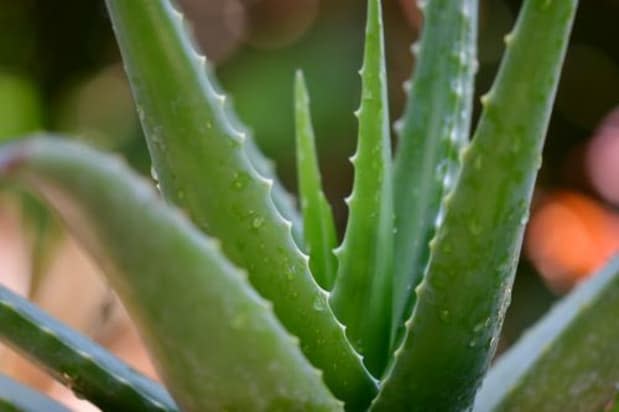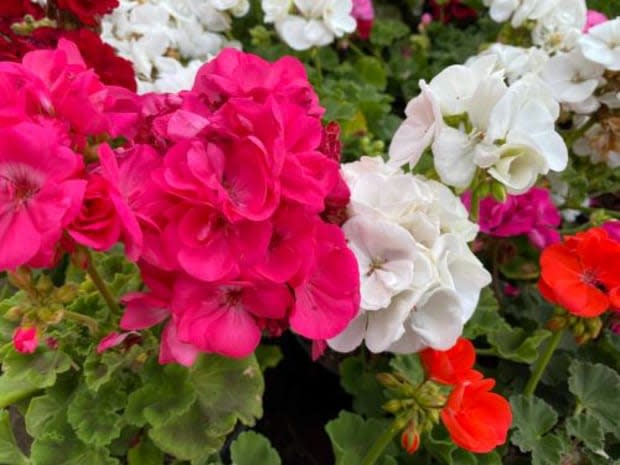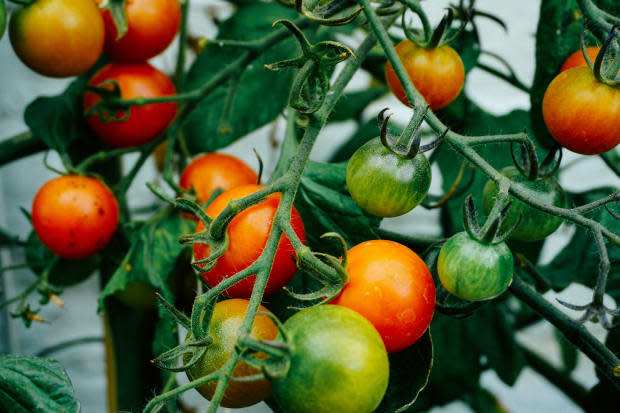Pet and Plant Parents, Pay Attention! These 29 Plants Are Poisonous to Dogs
Keep your best friend healthy and safe.
When it comes to the well-being of man's best friend, immunizing, spaying or neutering, giving flea meds and keeping annual physicals are vital. But did you know that you should include taking an inventory of the plants you keep inside—as well as those growing in your landscape? Yep, there are plants poisonous to dogs that you need to know about.
First-time and experienced dog owners should be aware of the plants inside and outside their homes that could cause harm to their dogs. When babies start crawling and walking, parents will search their homes for dangers by "baby proofing," and dog owners should do the same with plants—"puppy proofing," if necessary, to keep their pets safe.
Although some plants only cause mild symptoms like rash or vomiting, others are very toxic, causing death. Read over this list of 29 poisonous plants for your dogs, becoming familiar with all of the pictures too. It may just save your dog's (or someone else’s dog’s) life in the future!
Related: Avoid Getting Eaten Alive This Summer With These 25+ Plants That Repel Mosquitoes
What To Do if You Suspect Your Dog Consumed Something Toxic
This article is not meant to encourage you to stop growing houseplants or rip out anything in your landscape that may be a hazard to your dog. A lot of times you already have some of these plants in your home or in your flowerbeds. You can move a plant higher up, or into a room where you know your dog can’t get to it.
If you have a plant already established, move it to a different location outside of where your dog will roam. And before purchasing any new plant, just check whether or not it is safe for your dog first, before bringing it home.
I worked in a vet clinic (off and on) for about four years and had seen several dogs during that time that had become extremely sick from consuming plants that are noxious to them. It is not a pleasant experience to witness.
In the case that your dog has ingested something you believe to be toxic, acting calmly and quickly can be the key to getting them the help they need in making a quick recovery.
Here are the immediate steps you should take if your dog has eaten a poisonous plant:
Call your vet or emergency vet immediately if you suspect your dog has eaten something that may be toxic.
Be ready to give the vet as much of the following information: your dog’s breed, age, weight, the time plant was ingested and any symptoms your dog is displaying (e.g., vomiting, diarrhea, lethargy, rash)
If possible, grab some of the plant your dog ingested and bring it with you to the vet, or take a photo.
Collect some of the vomit in a small bag if you are unable to identify which plant the dog ate.
The National Animal Poison Control Center is another resource to use and is manned 24 hours a day. Sponsored in part by 36 different companies, you can reach them at 888-426-4435.
In addition, please remember that it is only a myth that a dog will instinctively avoid dangerous plants—especially puppies!
And lastly, do not intentionally induce your dog’s vomiting, unless instructed to do so. You could actually cause more harm than good to your dog.
Related: OMG, You'll Definitely Want These Ear-resistable 'Bunny Succulents' for Your Home This Spring
29 Plants Poisonous to Dogs
1. Aloe
A spikey green succulent, this popular houseplant can cause your dog mild symptoms when ingested. By increasing mucus production and water within the colon, dogs' primary discomfort is vomiting and diarrhea. Changes in the dog's urine color, possible tremors and depression can also be indications of aloe poisoning.
2. Amaryllis
Amaryllis are gorgeous bulb-blooming flowers around Christmas time that can cause quite a list of symptoms in your dogs if eaten. These include depression, vomiting, tremors and anorexia, and may cause excess salivation.
3. American Holly
American holly plants are beautiful bushes, commonly adorning people's landscapes and enjoyed by many birds. But these berry-producing greeneries are not so good for dogs. (Nor are the other holly varieties like English, Japanese or Christmas holly.) The leaves will induce vomiting and other gastrointestinal injuries. Signs that your dog has eaten a holly plant, or its berries, could include lip-smacking, drooling or head shaking.
4. Autumn Crocus
In the spring, autumn crocus will grow large green leaves out of the ground. As summer progresses, the leaves die. Once fall comes, small purple flowers will poke up out where the leaves were. Because of this, it may be harder to keep track of your dog's activity around this plant. If you suspect that your dog has eaten some crocuses, do not hesitate to take them to a vet immediately—they won't always show signs of distress right away from this plant. This is an extremely toxic plant that can cause liver and kidney damage—even respiratory failure.
Related: It’s Actually Surprisingly Easy Being Green! 55+ Plants You Can Grow in a Hydroponic Garden
5. Azaleas
Azaleas are not only found commonly in landscape use, but also grow in the wild.
Being familiar with what the plant looks like will help you prevent your dog from eating it and developing serious issues like vomiting, diarrhea, drooling and paralysis, and even death.
6. Begonia
The bright, cheery and long-lasting flowering plant makes begonias a beloved choice for gardeners. However, as appealing as they are, they can be painful for your pup—causing mouth irritation and difficulty swallowing.
7. Chrysanthemum
In the fall especially, mums are an attractive, colored-varied plant that decorate many porches. However, the flowers contain lactones and pyrethrin, which cause intestinal irritation. These are not deadly plants but will make your doggo quite uncomfortable. If gobbled up by dogs, you can expect them to experience vomiting, diarrhea, drooling, skin rashes and loss of coordination.
8. Cyclamen
Another toxic plant for your dog is the cyclamen—a very pleasant and unusual flowering plant well-liked by homeowners. But dog owners should know that a dog who eats this plant in large amounts can develop seizures or possibly die.
9. Daffodil
It is always so cheerful when the weather warms and the daffodils start springing into action. Any part of the daffodil is harmful to your dog, but especially the bulbs. Severe vomiting, drooling, tremors and possibly heart problems can emerge in a dog after being snarfed up.
10. English Ivy
English Ivy is an incredibly hardy plant for growing both inside and outside. However, it causes irritation on dogs who roll around in or eat the plant. Watch for things like drooling, vomiting, diarrhea or a swollen mouth and tongue if your dog is seen near English Ivy.
11. Foxglove
Very tall and amazing flowers develop on the foxglove during its blooming season. But this is a very toxic and dangerous plant for your dog—every piece of it. From the seeds to the petals and flowers, it all can cause cardiac failure and death in dogs.
12. Geranium
This mosquito-hating flower is everywhere during the summer months because it is so versatile and easy to grow. But to dogs, they are poisonous, causing symptoms like loss of appetite, low blood pressure and skin rashes.
13. Grapes
Dogs should never eat grapes of any kind. And grape plants are used, at times, as decoration in many landscapes. They can even grow wild—so beware in case your dog roams a bit. Grapes cause kidney failure and death in dogs.
Related: What Are Annual Plants? Plus, Gorgeous Annual Varieties That Make for a Stunning Garden
14. Hosta
Hostas are everywhere in gardens, pots and rock beds. Not much kills them, and they propagate quickly and easily. But the plant contains saponins, which are toxic to dogs, whether they eat or just play around in them.
15. Hyacinth
These beauties pop up every year around spring and are great gifts for Easter. The best part is that after they are done blooming, you can plant the bulbs and enjoy them the next year. But don't forget where you plant them if you have dogs. Oxalic acids are alkaloids in the plant that are harmful for your K9s, producing mild, but uncomfortable symptoms like mouth pawing, excessive vomiting and diarrhea.
16. Hydrangea
Described as big puff balls, hydrangeas are treasured by many people. That being said, the toxins that impact dogs are found in both the flowers and leaves and can cause lethargy, vomiting and other stomach upsets.
17. Iris
These flowers shoot right up during the spring on long stalks, protruding out and away from their thick green leaves. Coming in a large variety of colors, Iris can give dogs the "runs" for their money when eaten by them. Diarrhea is a common symptom, along with lethargy, drooling, vomiting and skin irritation.
Related: Got a Green Thumb? Get Ready To Give This ‘Monstera’ List of Plant Memes a Big Thumbs Up
18. Jade Plant
The jade plant is a succulent for either indoor or outdoor inspiration. Dogs do seem to like the taste of jade, but jade doesn't agree well with their stomachs, often creating some serious medical issues.
19. Juniper (Berries)
The scale to which a dog's symptoms transpire from eating juniper berries depends heavily on how much they eat and the size of the dog eating them. Eating large amounts of berries can cause kidney issues, but smaller amounts will only create vomiting issues and maybe some diarrhea too.
20. Kalanchoe
Kalanchoes are adorable flowers that come in a wide assortment of colors to delight in. Regrettably, kalanchoe can wreak havoc on a dog's internal system, leading to various problems like vomiting, weakness and heart arrhythmias.
21. Lilies
Lilies can be a beautiful attraction throughout spring and summer—they may grow around your home, or they can populate on their own in the wild.
That being said, all lilies should be off-limits to dogs. This includes Easter lilies, daylilies and calla lilies. It is just easier to remember that they are all harmful to your dog, instead of trying to recall which lily causes which symptoms. Daylilies are only mildly upsetting to your dog, but others like calla lilies can burn and irritate your dog's mouth and stomach. Just a couple of lily tubers can be fatal for a dog, so avoid them at all costs.
22. Lily of the Valley
Lily of the valley makes an excellent ground cover, and their little bell-shaped flowers smell divine. However, if a dog ingests the plant, it could cause them to have vomiting, a drop in heart rate and diarrhea.
Related: Polka Dot Plant Care! How To Grow Pink Polka Dot Plants Indoors
23. Marijuana
Absolutely everything to do with marijuana is harmful to a dog if ingested. The actual plant—including leaves, seeds, stems and flowers—can all poison your dog. Also, smoke inhalation and consuming oils can also pose a serious threat to your pet.
24. Morning Glory
This trailing vine plant sprouts tiny flowers during the morning hours, closing up shop for the rest of the day. If a dog decides to eat this plant, there is a chance your dog will show one or more of the following indicators: anemia, vomiting, liver failure, lethargy, tremors and loss of appetite.
25. Peony
In the peony's bark, there is a toxin called paeonol. Large amounts of this being munched on will cause a canine to vomit and or get diarrhea.
26. Rhododendron
It doesn't take much for a rhododendron to negatively impact a dog. Very small amounts of this plant are all it takes to make your dog very miserable, or possibly cause death if they eat too much.
27. Tomato
Dogs can actually eat ripe tomatoes in small amounts without any effects; the toxins are in the plant itself. Solanine is found mostly in the green part of the tomato plant. (So, no green tomatoes either!)
Smaller dogs, especially, could suffer symptoms like dilated pupils, muscle weakness, tremors, seizures and/or cardiac symptoms.
28. Wisteria
A wispy lavender flowering plant, wisteria can become fatal to a dog if just a few seed pods are eaten (especially true in smaller dogs if they ingest too much). Lectin and wisterin glycoside are the two toxins that cause problems with your dog's health functions. Lectin could cause stroke or blood clots, while wisterin glycoside can cause fatalities from uncontrollable diarrhea and vomiting.
29. Tulip
Tulips signal that it's springtime with their cheery blooms. But dogs could have a reaction in their mouths or esophagus if they decide to nibble on them. Any part of the flower can be harmful, but the bulb is the main culprit of excessive drooling and vomiting. Negative effects from eating tulips can be controlled by a vet, and a dog usually recovers quickly.
Next, These 75 Different Types of Succulents Are Not Only Gorgeous—but Also Hard To Kill





























